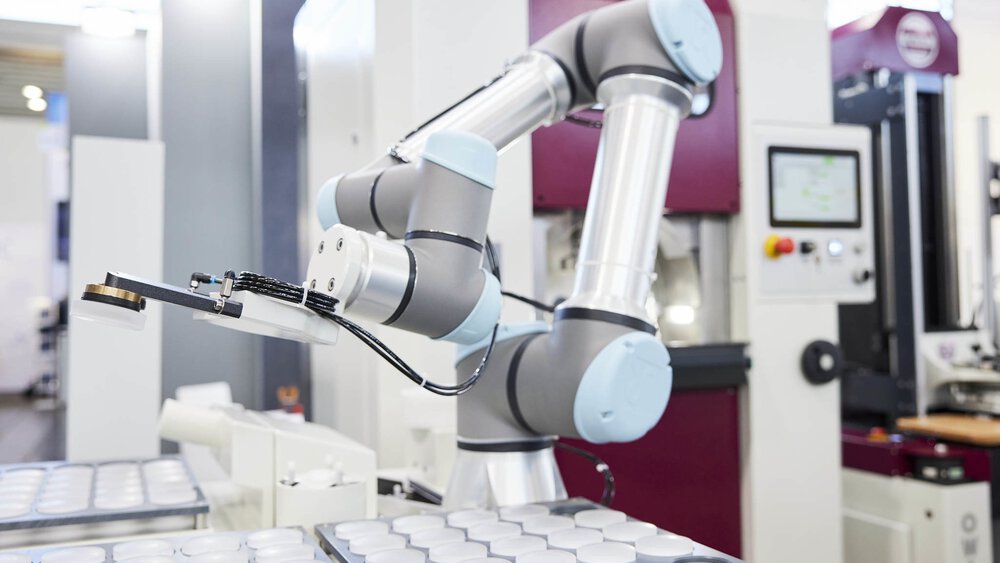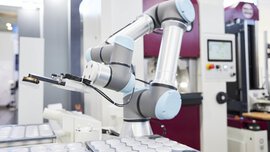AI prompts innovation boost in photonics
April 9, 2025
- Pioneer of fully automated first-time-right production
- Great potential for imaging and automated laboratory processes
- Photonic solutions for energy-efficient AI data centers
Artificial intelligence is a driver of innovation in photonics. Whether in industrial production, quality assurance, medicine and research or agriculture and environmental technology, the interaction between AI and photonics opens up new possibilities. Laser World of Photonics and automatica will bring together leading players in this young field of technology from June 22 to 27, 2025.
When lasers destroy weeds sprouting in fields at full speed, sort living cells under microscopes in high-throughput processes, or enable the single-origin recycling of high-quality materials by bombarding them with plasma clouds for spectroscopic analysis, artificial intelligence (AI) now ensures precision, reliability and speed. AI opens up new horizons. And it has a major impact on value creation and business models in photonics.
AI refines process data into information with added value
Advancing digitalization and sensor-based process monitoring provide raw data from which algorithms draw information with added value. This accelerates research and development projects, saves iteration loops in the design of optics and beam paths and, in combination with AI-supported virtualization, reduces the number of real tests. Where AI, digital twins and simulation work together, Industry 4.0 becomes a reality.
One goal is to use this to generate parameters for fully automated first-time-right production. At the same time, photonics-driven progress in sensor technology, imaging and data processing is paving the way for real-time process monitoring as the basis for AI-based on-the-fly adaptation of the process parameters. This makes the vision of self-learning machines and ultimately closed control loops in laser processing tangible.
LASER exhibitors consistently combine photonics and AI. They use AI for automated component optimization and for more efficient, more productive and less failure-prone process chains in laser cutting, bending and welding. Neural networks replicate how the brain learns, a process that took evolution to perfect, at the speed of light and thus filter previously inaccessible information from large volumes of data. In ongoing laser processes and quality assurance, AI supports the detection, segmentation and evaluation of hidden defects and anomalies in camera or CT images. In hospitals and laboratories, it ensures fast and reliable results.
AI accelerates microscopy and its analysis
Well-trained AI algorithms filter large amounts of data much more reliably and faster than humans. Microscopy providers use the technology along the entire process chain: AI helps place and recognize samples, supports focus adjustment and image acquisition, corrects noise when examining living cells under the microscope, and automates 3D reconstruction, image segmentation and object classification. Even with gigabytes or terabytes of image data, these process chains deliver results swiftly. Scaling leads to more reliable findings in research and diagnostics as AI-based analytics is underpinned by much larger volumes of data.
Highly specialized medium-sized companies driving the use of AI
The AI revolution is not limited to companies like Coherent, TRUMPF or ZEISS. Quite the opposite: Medium-sized companies such as Precitec and Scansonic are well advanced when it comes to AI-supported laser welding, laser soldering and the accompanying measurement technology. “AI methods are changing everyday life in the photonics industry,” says Dr. Markus Kogel-Hollacher, Executive Director of the Laser Technology Working Group (AKL e.V.) and responsible for research and development projects at Precitec Group, adding that AI has major potential, particularly in laser processing. After all, wherever photons penetrate workpieces and take effect, there are many uncertainties. All key process input variables must be meticulously adhered to in order to rule out quality fluctuations. Sensor technology and AI help and expand the options: “It is no longer just about good or bad. Instead, with AI, we elicit precise statements from optical process data about physical properties such as the strength or contact resistance of a weld seam,” he explains. He says that AI-supported inline quality monitoring creates real added value in the laser welding of batteries, fuel cells or consumer electronics.
Photonics for smart factories and energy-efficient AI data centers
Christoph Franz, Managing Director of 4D Photonics GmbH, has a similar view:
“Smart factories of the future will need lean, flexibly integrable solutions that enable AI-supported, multi-sensor process monitoring and evaluation.” AI filters relevant information from the massive quantities of sensor data generated to improve processes. His company uses multispectral imaging to generate this data. A single sensor easily, quickly and dynamically supplies the amount of data required to examine laser processes with the necessary precision and provide relevant information on the cause of errors in the process.
The interaction between photonics and AI goes beyond that: Providers of integrated photonics, including Coherent and Q.ANT, are driving forward purely optical computing processes and data transmission. “Our photonic processors replace electrons with light, hence making it possible to reduce energy requirements by a factor of 30 while increasing computing density by a factor of 50,” reports Q.ANT Managing Director Dr. Michael Förtsch. A real paradigm shift. His conclusion: “A more scalable, more cost-effective and more energy-efficient AI future is possible.” Photonics is the way to get there.
Laser World of Photonics 2025 will address the megatrend of AI in photonics in the application panel “From Theory to Practice: Implementing AI in Laser-Based Manufacturing Processes” (Tuesday, June 24, 11:00-13:00, Hall B3). There will also be a topic-specific crossover zone between LASER and automatica entitled “Photonics meets Robotics: AI Success Stories” (Hall A3).
Downloads
197269
Belonging images



- PR Manager
